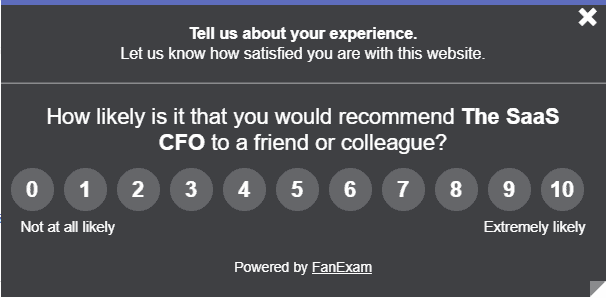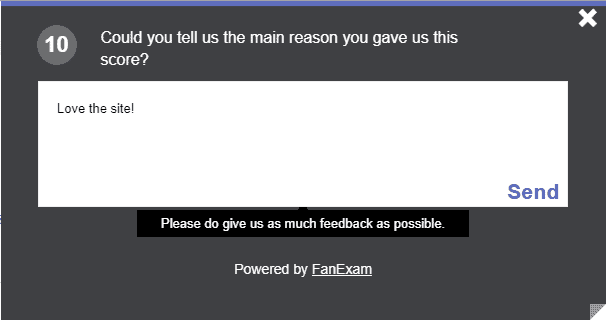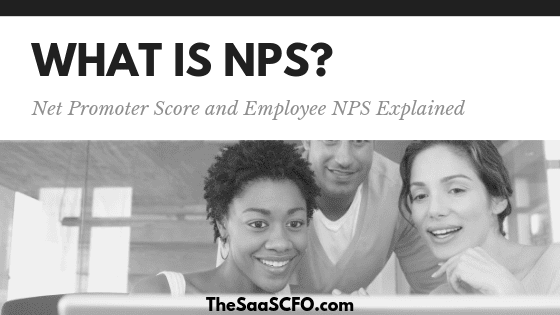The Net Promoter Score, or NPS(®), is a customer satisfaction benchmark that rates the likely-hood of your customer recommending your product or service to someone else.
Your customer rates you on an NPS scale that begins at 0 (unlikely) and ends at 10 (likely). The scores are then transformed into a -100 to +100 NPS score.
NPS Survey
An NPS survey is typically a simple, one question survey that may be emailed to your customer or delivered through an in-browser or in-product pop-up form. It also includes a text box asking for a free form response from the recipient.
The screenshot below is the pop-up that I use on my site to survey readers. My NPS score typically ranges in the 50’s.

The text responses provide invaluable feedback on the satisfaction or frustration of your customer, reader, or subscriber. Initially, NPS was company-focused, but now you see the NPS rating in a wide variety of settings including blogs like this. NPS surveys can either be anonymous or tied back to a specific customer.

NPS Ratings
An NPS survey asks the recipient to rate your company or product on a scale from 0 to 10. The 0 to 10 rating is bucketed into three categories of respondents. These include promoters, passives, and detractors.
Promoters – a rating of 9 or 10 classifies the survey taker as a promoter. These are enthusiasts of product and very likely to recommend your product or service to someone else.
Passives – a rating of 7 or 8 classifies the survey taker as a passive. They may like your product or service but are indifferent. They are riding the fence and have the potential to slip or up down the scale.
Detractors – a rating from 0 to 6 classifies the survey taker as a detractor. They are unhappy customers or readers who would not recommend your product or service. From experience, it’s most worrisome when you receive a 0, 1, or 2. NPS almost needs another customer persona in this range. It’s possible they may spread a negative message about your product. A rating of 0, 1, or 2 is when I really want constructive feedback in the text box.

How to Calculate an NPS Score?
The calculation of the NPS score is straight forward. I lay out the steps below.
- First, calculate the percentage of respondents who rated you as a promoter (9 or 10).
- Second, calculate the percentage of respondents who rated you as a 0 to 6.
- The net promoter score is calculated by subtracting the % detractors from % promoters.
That’s it! I created an example NPS calculation below. You can download my example NPS score calculator in Excel at the bottom of this post.

What is a Good NPS Score?
You started surveying your customers and are receiving responses. Now what? What is a good NPS score?
Based on the software that I use to collect scores, it breaks down as follows (left-hand table). After a little searching, I also found an alternate table (right-hand table).

As you can see, there might not be a standard yet. And bench marking data seems to be spotty. However, you can check out an NPS benchmark article here by Bain and Company. Of course, once you send out your initial survey, that score will be your internal benchmark to improve upon.
What is a Good NPS Response Rate?
According to Retently, NPS surveys have a much better response rate than typical email campaigns. Effective NPS campaigns have a 30-40% response rate while business email campaigns average a 20% open rate and 2-3% click rate (response rate).
Of course, your experience could differ as everyone’s response rate differs based on subject lines, copy, etc.
What is Employee NPS (eNPS)?
The NPS score is now being focused on internal company topics such as employee happiness or sentiment. This is called the employee net promoter score or eNPS. eNPS surveys are very similar to traditional NPS.
You may have seen an NPS survey on my site. The insight is amazing and sometimes a bit painful to digest. But it provides amazing feedback that you can use to drive change in your product, features, or strategy. Imagine applying the NPS score to your staff.
After all, employees are a software company’s biggest asset. Competitive advantage is driven not by the product but the people who are creating the product and driving the company forward.

Strong employee promoters can drive improved company performance through better engagement, better customer experiences, and their overall positive energy inside your teams.
It only makes sense that company leaders would like to understand the internal vibe of the office and improve upon it. From my experience, a good human resources department can often pick up on the office vibe, but this can be somewhat subjective and hard to translate to your executive team or Board in a PowerPoint slide.
Benefits of an Employee Net Promoter Score
Translating employee sentiment into an eNPS score, although not perfect, can provide great insight into culture, retention, and motivation. As a CFO, of course, I like quantification and measurable results. Rather than relying on subjective measures, the eNPS survey attempts to quantify the office vibe or sentiment.
In addition to receiving a rating, employees have the chance to provide anonymous text feedback via eNPS surveys. Again, the insight from this eNPS feedback is invaluable. As soon as text feedback comes back on my site, I am reading it within minutes.

How often have you been in a Board meeting or executive meeting and been asked about employee morale? It’s such an important topic but hard to translate “water cooler talk” to your Board without some method of quantification via an eNPS survey.
Gone are the days of huge, time-consuming annual employee surveys and even the annual performance review. Short, quick, actionable feedback is dominant now. You can course correct throughout the year rather than just once a year.
Action Items
Today, there are so many solutions offering some sort of feedback mechanism that there is no excuse for not asking for feedback. You may think that you have the best website, product, or culture, but you don’t know until you ask for honest feedback. It’s been key in setting the direction for this blog.
Think about the areas in your business that would benefit the from actionable feedback. Then consider how you can implement an NPS survey for your customers and an eNPS survey for your employees.
Have you implemented NPS or eNPS in your business? Please share your experiences and NPS tool below.
I have worked in finance and accounting for 25+ years. I’ve been a SaaS CFO for 8+ years and began my career in the FP&A function. I hold an active Tennessee CPA license and earned my undergraduate degree from the University of Colorado at Boulder and MBA from the University of Iowa. I offer coaching, fractional CFO services, and SaaS finance courses.
